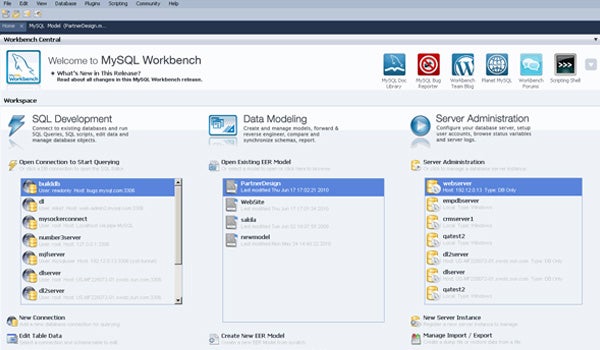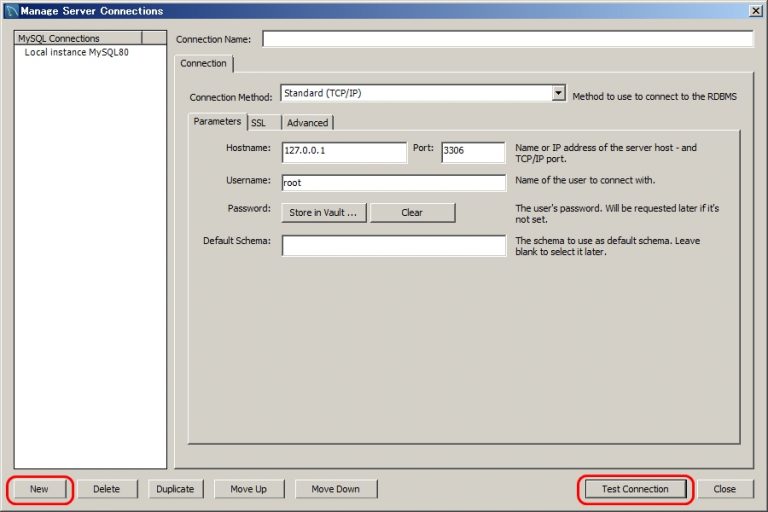
- #MYSQL WORKBENCH EXPORT CONNECTIONS HOW TO#
- #MYSQL WORKBENCH EXPORT CONNECTIONS PASSWORD#
- #MYSQL WORKBENCH EXPORT CONNECTIONS PLUS#
You can also disconnect a client by clicking the Kill Connection/s button. It also shows how many threads were created, are connected, running, how many errors, and more. In the Database System field, select MySQL. The Client Connections screen shows how many clients are connected to this instance of MySQL. Configure source database server connection parameters On the Overview page, select Start Migration. This will open the Client Connections screen, which shows the current connections to this instance of MySQL. Option 2: By GUIĬlick on Client Connections in the Management tab of the left navigation pane: The “Client Connections” link in the left navigation pane in MySQL Workbench. Run SHOW PROCESSLIST in a query tab: Running “show processlist ” in a query will result in current connections being displayed.

First, open MySQL Workbench and click the + icon next to MySQL Connections. By GUI: Click on Client Connections in the Management tab of the left navigation pane. Once we have your SSH key on our server, configure MySQL Workbench to connect. Starting with version 7.1 (14), you can export Workbench connections from the Connections Manager to an encrypted file.By Query: Run SHOW PROCESSLIST in a query tab.To import our saved books.sql file created earlier, we’d use many of the same flags and much the same syntax.You can use MySQL Workbench to view current connections in MySQL either by query or by GUI. Double-click on it to establish a connection to your hosting account and start managing your databases. Then on the main window of the MySQL Workbench software, you will see a new connection show under the MySQL Connections line. In most cases, importing is just a matter of passing virtually identical options to the mysqlimport command. If the connection was established properly you will see a success notification. In this window, you’ll be given to select. Step 3: A Table Data Export window will pop up. Right-click on the table and select the option called Table Data Export Wizard. Step 2: Open the Schema tab, and select the data and corresponding table you want to convert to a CSV file.
#MYSQL WORKBENCH EXPORT CONNECTIONS HOW TO#
Now that you’ve learned how to export a backup of a MySQL database, we’ll explore how to reverse the process and import the backup into an existing database.Īs you might imagine, to compliment the mysqldump command used for exporting, there is a similar mysqlimport command for importing. Step 1: Open MySQL Workbench and connect to MySQL instance.

If you need the ability to export (and later recreate) one more more databases, read up on the -databases flag in the official documentation.
#MYSQL WORKBENCH EXPORT CONNECTIONS PLUS#
Instead, by default, only actual tables (and their respective data) are saved and thus will be prepared for later import using this file. From the Welcome page, click on the plus sign ( + ): Enter the name for your connection. sql suffix (which is completely optional but advisable) in the appropriate directory.īy default, mysqldump will not save commands which attempt to modify the existence of the actual database. Select the checkboxes corresponding to the databases you want a backup for. Next up, you’ll see a tab on your workbench for data export where you’ll see a list of all your databases.

After connecting to the Workbench, click Server on the menu bar and select Data Export.
#MYSQL WORKBENCH EXPORT CONNECTIONS PASSWORD#
$ mysqldump -u book_admin -p books > ~/backup/database/books.sqlĪfter entering our password when prompted above, this command then creates our backup file with a. First of all, we’ll to connect to MySQL Workbench.


 0 kommentar(er)
0 kommentar(er)
